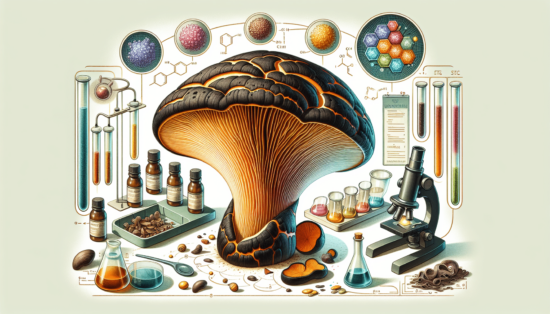- Introduction
- Healing active ingredients
- Health benefits
- Chaga in cancer research
- Chaga in traditional and modern medicine
- Chaga cultivation and sustainability
- Notes and side effects
- Conclusion and outlook
Here you can find our Chaga products!
1. introduction
Chaga, known as Inonotus obliquus, grows on birch trees in colder regions and is rich in biologically active compounds such as polysaccharides, triterpenes, sterols and phenols. These components provide antioxidant, anti-inflammatory and immunomodulating properties [1]. Chaga, which can be consumed in the form of tea, capsules or powder, contains over 200 different nutrients, including vitamin B, minerals and phytochemicals, and is considered a non-traditional superfood due to its powerful antioxidant and anti-inflammatory effects [1] [2]. In addition, the chaga mushroom has a long history in various cultures, especially in Russia, Finland and Estonia, where it has been used for centuries in traditional teas, foods and drinks for its health benefits [3] [4].
Throughout this article, we will explore the healing properties of Chaga and its health benefits, including its roles in cancer research and traditional and modern medicine. We'll also shed light on chaga cultivation and the importance of sustainability, followed by important notes and possible side effects. This knowledge will allow you to gain a deeper insight into the potential benefits that chaga can offer in the field of healthcare, particularly in relation to cancers such as liver, colon and cervical cancer, as well as in lowering LDL cholesterol levels and supporting heart health through its antioxidant and anti-inflammatory properties [3] [8].
2. healing active ingredients
Active compounds in Chaga
- Sclerotium and betulin
- The Chaga mushroom grows as a sclerotium or "secondary fruiting body" on birch trees and absorbs betulin from the birch bark, which is considered an effective free radical scavenger [5].
- Diversity of bioactive compounds
- Chaga contains a variety of bioactive substances, including polysaccharides, antioxidant enzymes, triterpenes, flavonoids and sterols such as inotodiol, lanosterol and ergosterol [5].
- These compounds include betulin, which is found in birch bark and is attributed to the Chaga mushroom as having anti-cancer properties [12].
- Inotodiol, a molecule specific to Chaga, shows anti-inflammatory and antihistamine effects [8].
- Polysaccharides and their effects
- Polysaccharides, especially beta-1,3- and beta-1,6-D-glucans, are largely responsible for the health benefits of chaga, including its anti-cancer, blood sugar-lowering, antioxidant and anti-inflammatory properties [4].
- The polysaccharides in chaga have also been studied for their potential antidiabetic, anticancer and immunostimulatory effects [10].
- Melanin and antioxidant properties
- The high melanin content in chaga contributes to its strong antioxidant properties [10].
Composition and health benefits
- Over 200 biologically active substances
- Chaga mushrooms contain over 200 active biological substances, the most important of which are polysaccharides, polyphenols, triterpenes and melanin [11].
- Anti-cancer and anti-inflammatory properties
- Betulinic acid, a triterpenoid that is abundant in chaga, has been shown to have anti-cancer and anti-inflammatory effects [8].
3. health benefits
Immune system and antiviral effects
- Strengthening the immune system
- Chaga mushrooms can strengthen the immune system by increasing the activity of immune cells and reducing inflammation [1].
- The polysaccharides in Chaga increase the cell division of lymphocytes, which strengthens the immune response [9] [10].
- Antiviral activity
- Chaga extract shows antiviral activity against SARS-CoV-2, indicating potential as a treatment for COVID-19 [1].
- The anti-inflammatory properties of Chaga could reduce the risk of cytokine storms in COVID-19 patients [14].
- Chaga has also shown antiviral properties against herpes and influenza viruses [16] [17].
Liver and heart health
- Liver protection
- Chaga can protect the liver by reducing liver damage from alcohol or other toxins and lowering liver enzymes, indicating improved liver function [1].
- Heart health
- Chaga contributes to heart health by lowering cholesterol levels and regulating blood pressure [7].
Diabetes management and antioxidant properties
- Type 2 diabetes
- Chaga can support insulin sensitivity and regulate blood sugar levels, which can be particularly beneficial for people with type 2 diabetes [11].
- Studies suggest that Chaga extract can lower blood sugar levels and improve insulin resistance in mice [1].
- Antioxidant effects
- Chaga contains beta-D-glucan, which strengthens the immune system and has antioxidant properties that neutralize free radicals and reduce the risk of chronic diseases [7].
- Melanin in chaga also offers antioxidant and anti-inflammatory effects [11].
Skin health and anti-inflammatory effects
- Skin conditions
- Chaga is traditionally used to treat various skin conditions such as acne, neurodermatitis and psoriasis, due to its antioxidant and anti-inflammatory properties [12].
- A study from 1973 showed that Chaga was effective in the treatment of psoriasis, with 38 out of 50 participants being completely cured.
- Anti-inflammatory effects
- Chaga can reduce the production of pro-inflammatory cytokines and thus reduce the risk of chronic inflammation.
- Chaga supports the balance of the intestinal flora, which is essential for healthy skin [4].
Further health benefits
- Chaga supports cognitive functions and could reduce the risk of cognitive diseases such as Alzheimer's [7].
- Chaga promotes the growth of beneficial intestinal bacteria and can improve various gastrointestinal complaints [13].
4. chaga in cancer research
Use of chaga in cancer therapy
- Preventive properties
- Chaga is used in modern mycotherapy as a preventive treatment against cancer, mainly due to its strong antioxidant properties, which can potentially contribute to cancer prevention.
- Support during chemotherapy and radiotherapy
- In cancer therapy, chaga is used to alleviate the side effects of chemotherapy and radiotherapy and to support the immune system in recognizing and attacking cancer cells [5].
Research results on chaga and cancer
- Antitumor activity
- Numerous cell studies have investigated the antitumor activity of Chaga. Animal studies have shown that Chaga extract can slow down or inhibit the growth of tumors [4].
- Further studies have shown that chaga can inhibit the growth of cancer cells. A study from 2018 found that Chaga extract can suppress the growth of cancer cells, and a study from 2023 found that Chaga extract can inhibit the growth of breast cancer cells [30].
Challenges and restrictions
- Limited scientific evidence
- There is no scientific evidence that chaga has healing effects in the treatment of diseases such as cancer, diabetes and liver problems [14].
- Several studies on chaga have been conducted, but mainly in laboratories on cultured cells or on experimental animals with artificially induced diseases. No solid conclusions about the effects of Chaga on the human body can be drawn from these studies [26].
- Need for research
- Further research is needed to fully understand the effects of chaga on diabetes and cancer, and it should not be used as a substitute for medical treatments [1].
- Whether chaga can help with cancer or other diseases or whether it has preventive effects remains unclear [26].
Immune system and cancer defense
- Boosting the immune response
- Chaga has been shown to increase the proliferation of lymphocytes (a type of white blood cell) in mice, which boosts the immune response [4].
- The antitumor effect of chaga is attributed to its polysaccharides, although the exact mechanism is not yet fully understood [3].
- Studies on mice have shown that Chaga extract can slow or inhibit tumor growth and reduce the number of metastases [3].
5 Chaga in traditional and modern medicine
Chaga, also known as Inonotus obliquus, is traditionally consumed in various forms. Especially in the traditional medicine of Lapland and Siberia, Chaga has a long history as a tonic, anti-cancer agent and to support the digestive system [5]. In these regions, Chaga is often prepared as a tea or used in powder form [5].
Traditional applications and forms of preparation
- Tea and powder
- Chaga can be prepared as a tea by infusing chaga powder or pieces in hot water. This traditional form is often used to take advantage of the health benefits of chaga [3] [4].
- Versatile use in folk medicine
- In folk medicine in Siberia and Russia, chaga was used to treat various ailments such as parasites, tuberculosis, inflammation, stomach problems, heart and liver disease, diabetes and cancer [4].
- Other forms of application
- Chaga was also historically used in the form of infusions, inhalations, water extracts or antiseptic soaps and was even used as a tea substitute [4].
Modern use and scientific studies
- Skin health
- Traditionally, chaga has been used to treat various skin conditions such as acne, neurodermatitis and psoriasis. A study from 1973 showed that a Chaga extract could help in the treatment of psoriasis, with 38 out of 50 participants showing a complete cure [9] [14].
- Histamine reduction
- Due to its histamine-lowering effect, chaga can help people with histamine intolerance to reduce symptoms and improve tolerance to histamine-rich foods [9].
Forms of consumption in modern medicine
- Chaga can be consumed as a tea, tincture or powder, with the traditional form being tea made from chaga pieces [4].
6 Chaga cultivation and sustainability
Sustainable cultivation methods
- Use of organic Chaga
- Buying organic Chaga not only guarantees high quality, but also supports environmentally responsible farming methods and sustainable agricultural practices [15].
- Free from harmful substances
- Organic Chaga products are free from pesticides and other harmful substances, making them a safe choice for consumers [15].
- Sustainable harvesting methods
- When harvesting chaga, only part of the mushroom is removed to allow regeneration and ensure long-term availability [4].
- Quality assurance
- It is important to pay attention to quality and sustainability when buying Chaga products and to choose suppliers that use controlled organic cultivation or environmentally friendly wild harvesting methods [5].
Controlled cultivation and environmental impact
- Cultivation on birch trunks
- The sustainable cultivation of Chaga mushrooms takes place on birch logs or wood chips in controlled environments, which minimizes the risk of contamination and reduces the environmental impact.
- Quality control
- The Chaga mushroom from Estonia is considered to be of particularly high quality due to the cold climate and is carefully harvested by hand, making sure that the tree is at least 5 years old and that the Chaga growth is at least 10 to 15 meters high.
- Organic and environmentally friendly packaging
- Chaga mushroom powder sold by tea exclusive is organic, additive-free and comes in environmentally friendly packaging.
Long-term sustainability and source of income
- Time frame for cultivation
- The sustainable cultivation of Chaga takes 6-8 years after inoculation until the first harvest, whereby the Chaga mycelium is inoculated through plugs drilled into the tree.
- Multiple use of trees
- The tree inoculated with Chaga can be harvested several times, which represents a sustainable source of income for forest owners.
- Freshness and shelf life
- Chaga mycelium is a fresh and perishable product that is best used when it is as fresh as possible.
Environmental conditions and quality assurance
- Origin from untouched areas
- Chaga should be sourced from relatively untouched areas such as the northern parts of Finland, Norway or Canada, as mushrooms can absorb pollutants and radioactivity from their environment [4].
7 Notes and side effects
Safety and interactions
- Oxalate content and kidney problems
- Chaga contains high amounts of oxalates, which cautions people with existing kidney disease or other serious health conditions [4].
- Due to its high oxalate content, excessive use of chaga can lead to kidney damage and promote the formation of kidney stones [7].
- Interactions with medication
- Chaga can interact with certain medications, especially blood thinners and diabetes medications [7].
- Chaga can thin the blood and increase the risk of bleeding, which is particularly concerning for people taking blood-thinning medication [7].
Allergic reactions and dosage instructions
- Allergic reactions
- Although rare, some people may have an allergic reaction to chaga, with symptoms such as skin rashes and hives [7].
- Dosage
- The appropriate dosage of Chaga depends on the individual circumstances and the form of consumption [7].
- For Chaga tea, it is generally recommended to consume 1-2 cups per day, prepared by steeping Chaga pieces or powder in hot water for about 5 minutes [7].
- When using Chaga capsules or tablets, the manufacturer's dosage recommendations should be followed, which are often around 1000 mg per day [7].
- When using Chaga as a tincture or extract, the manufacturer's instructions should be followed as potency can vary considerably between products [7].
Quality assurance and FDA instructions
- Quality and authenticity
- When buying chaga, it is crucial to pay attention to quality and authenticity and to choose high-quality chaga that is wild-crafted and organically grown [11].
- Advice from healthcare professionals
- The quality and dosage of Chaga products can vary, so it is advisable to consult a health professional before using Chaga, especially for people with pre-existing conditions or who are taking medication [7].
- FDA approval
- Chaga is not approved by the FDA for the treatment of diseases [7].
Need for research
- Long-term studies
- Large-scale, long-term human studies are needed to confirm the potential health benefits of chaga and to establish its safety profile [9].
8 Conclusion and outlook
By exploring the traditional uses of Chaga and its potential modern medicinal applications, we have gained a profound insight into its diverse health benefits, from antioxidant and anti-inflammatory properties to assisting in cancer research and diabetes management. These properties underline the importance of chaga as a valuable addition to the field of natural healthcare and holistic therapies. At the same time, the sustainable cultivation and harvesting of Chaga is of great importance for the environment and the future availability of this wonderful natural supplement.
However, it is essential that further research is conducted to scientifically substantiate the full range of health benefits that chaga can offer. Readers are encouraged to experience the power of chaga for themselves, while also paying attention to quality, authenticity and sustainability. To discover the health benefits of chaga mushroom and find high quality products, please visit here. Finally, it is important to seek professional health advice when using Chaga products, especially for people with pre-existing conditions or who have existing medications.
Further questions and answers about Chaga
Where can you find Chaga mushrooms?
Chaga mushrooms grow mainly in colder regions of the northern hemisphere, particularly in Russia, Poland and Scandinavia. They can also be found in Mongolia, Japan and parts of North America.
What are the health benefits of chaga?
The chaga mushroom is said to strengthen the immune system, have antioxidant properties and have an anti-inflammatory effect. It could also have positive effects on the liver, gastrointestinal tract, blood sugar levels and stamina. Scientific studies are beginning to substantiate these effects.
Is it possible to eat chaga?
Although chaga is not considered an edible mushroom and is therefore not eaten directly, it can be consumed in the form of tea or as a trendy chaga latte. To make the tea, boil dried pieces of the mushroom in water and leave to simmer for around ten minutes before straining and drinking the tea.
How often can you drink Chaga tea?
It is recommended to drink Chaga tea three times a day before meals. The tea has the best effect if you give your stomach an hour after drinking it to digest and process the tea before you eat.
YouTube
References
[1] – https://spacegarden.de/blogs/magazin/chaga-studien
[2] – https://gumtamin.com/de-at/blogs/pilz-wissen-1/der-tschaga-pilz-moderne-gesundheit-mit-uralter-naturkraft
[3] – https://www.merkur.de/leben/gesundheit/chaga-pilz-wirkung-und-unsere-erfahrungen-mit-dem-vitalpilz-zr-92767585.html
[4] – https://www.zentrum-der-gesundheit.de/ernaehrung/lebensmittel/pilze-uebersicht/chaga-pilz
[5] – https://www.mykotroph.de/chaga/
[6] – https://www.verbraucherzentrale.de/wissen/lebensmittel/nahrungsergaenzungsmittel/vitalpilze-fuer-die-krebstherapie-21060
[7] – https://www.online-fitness-academy.de/magazin/chaga.html
[8] – https://utopia.de/ratgeber/chaga-pilz-wirkung-und-anwendung-des-finnischen-waldpilzes/
[9] – https://smaints.de/blogs/news/chaga-wirkung
[10] – https://www.sueddeutsche.de/supplements/vitalpilze/chaga-pilz
[11] – https://www.vehgroshop.de/chaga-pilz-pulver-bio.html
[12] – https://www.morawa.at/annot/564C42696D677C7C393738333434323232303634397C7C504446.pdf?sq=1
[13] – https://www.kostbarenatur.net/anwendungen-und-inhaltsstoffe/chaga/
[14] – https://medizin-transparent.at/chaga-pilz/
[15] – https://www.vehgroshop.de/superfoods/getrocknete-pilze/chaga
















